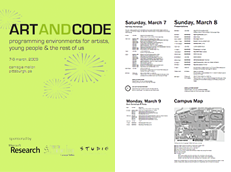processing.org
Presented by Casey Reas, Ben Fry, Ira Greenberg, and Daniel Shiffman
March 7, morning workshops 10am-1pm:
Workshop 1: A Patient Introduction to Processing for Total Beginners, Part 1 (Introductory; with C. Reas)
Workshop 2: A Brisk Introduction to Processing (Introductory/Intermediate; with Daniel Shiffman)
Workshop 3: Information Visualization with Processing (Intermediate; with Ben Fry)
March 7, afternoon workshops 2pm-5pm:
Workshop 4: A Patient Introduction to Processing for Total Beginners, Part 2 (Introductory; with C. Reas)
Workshop 5: Teaching with Processing: Considerations for the Classroom (for Educators; with Ira G.)
Workshop 6: Processing: Advanced Applications (Intermediate/Advanced; with Daniel Shiffman)
Workshop 7: Information Visualization with Processing (Intermediate; with Ben Fry)
March 9, “Hello World” workshops:
Getting Started with Processing, 9-10:30am
Getting Started with Processing, 10:30am-noon
Processing is an open-source programming language, development environment, and online community that since 2001 has promoted software literacy within the visual arts. Initially created to serve as a software sketchbook and to teach fundamentals of computer programming within a visual context, Processing quickly developed into a tool for creating finished professional work as well. It is used by students, artists, designers, researchers, and hobbyists for learning, prototyping, and production. It is created to teach fundamentals of computer programming within a visual context and to serve as a software sketchbook and professional production tool for programming images, animation, and interactions.
Processing is a free alternative to proprietary software tools with expensive licenses, making it accessible to schools and individual students. Its open-source status encourages the community participation and collaboration that is vital to its growth. Contributors share programs, contribute code, answer questions in the discussion forum, and build libraries to extend the possibilities of the software. The Processing community has written over seventy libraries to facilitate computer vision, data visualization, music, networking, and electronics. The Processing software runs on the Mac, Windows, and GNU/Linux platforms. With the click of a button, it exports applets for the Web or standalone applications for Mac, Windows, and GNU/Linux. Graphics from Processing programs may also be exported as PDF, DXF, or TIFF files and many other file formats.
Processing was founded by Ben Fry and Casey Reas in 2001 while both were John Maeda’s students at the MIT Media Lab. Since that time, Processing has received many significant awards and recognitions. The Cooper-Hewitt National Design Museum (a Smithsonian Institution) included Processing in its National Design Triennial. Works created with Processing were featured prominently in the Design and the Elastic Mind show at the Museum of Modern Art. Numerous design magazines, including Print, Eye, and Creativity, have highlighted the software. For their work on Processing, Fry and Reas received the 2008 Muriel Cooper Prize from the Design Management Institute. The Processing community was awarded the 2005 Prix Ars Electronica Golden Nica award and the 2005 Interactive Design Prize from the Tokyo Type Director’s Club.
Some ways in which Processing is used:
• Students at hundreds of schools around the world use Processing for classes ranging from middle school math education to undergraduate programming courses to graduate fine arts studios.
• Tens of thousands of companies, artists, designers, architects, and researchers use Processing to create an incredibly diverse range of projects.
• Design firms such as Motion Theory provide motion graphics created with Processing for the TV commercials of companies like Nike, Budweiser, and Hewlett-Packard.
• Bands such as R.E.M., Radiohead, and Modest Mouse have featured animation created with Processing in their music videos.
• Publications such as the journal Nature, the New York Times, Seed, and Communications of the ACM have commissioned information graphics created with Processing.
• The University of Washington’s Applied Physics Lab used Processing to create a visualization of a coastal marine ecosystem as a part of the NSF RISE project.
• The Armstrong Institute for Interactive Media Studies at Miami University uses Processing to build visualization tools and analyze text for digital humanities research.



